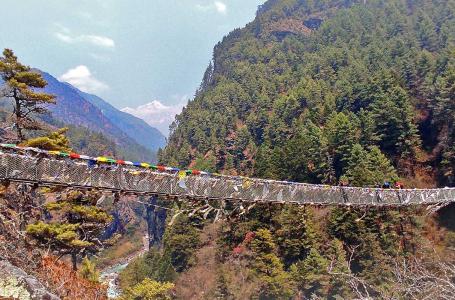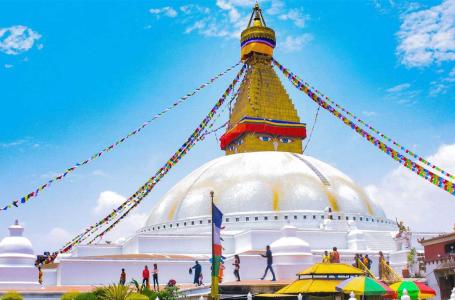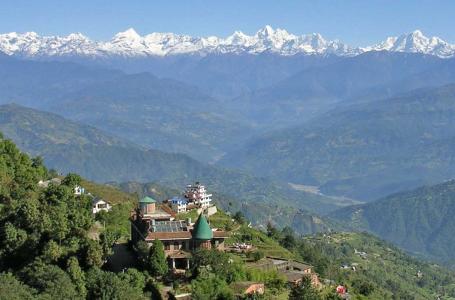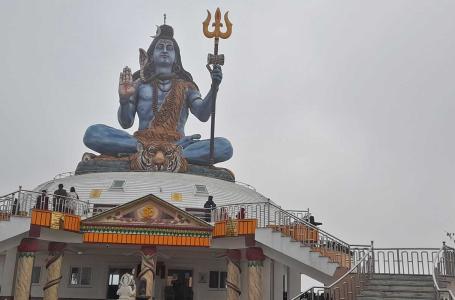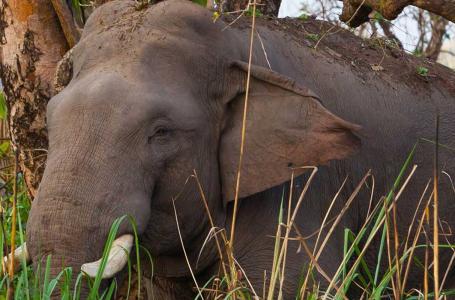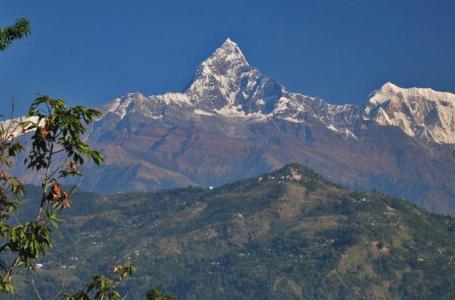Mera Peak Climbing is climbing to the highest trekking peak in Nepal which takes you to 6,461m/21,190ft. It offers the best views of five 8,000m peaks that are visible from the summit including Everest, Lhotse, Cho Oyu, Makalu, and Kanchenjunga along with dozens of other mountains of 6000 to 7000, Himalayan glaciers, icefalls, and deep Himalayan valleys.
Entering the Makalu Barun National Park, we see diverse flora and fauna. Although it is always possible to climb this peak as it is considered one of the trekking peaks of Nepal, Autumn (September, October, and November) and Spring (March, April, and May) are considered the best months for climbing this peak.
Mera Peak Climbing begins with the short, scenic, beautiful mountain flight to Lukla from Kathmandu (or Manthali). Flying over the mountain peaks, valleys, and hills, you will get perhaps the best scenery.
Instead of walking to Khumbu Valley, we walk following the route of Hinku Valley. On the way, we pass one of the high mountain passes Zatra La Pass which takes us the route that heads south from Lukla. We not only pass through the beautiful Nepalese wilderness but also through quaint villages which will give us a glimpse into the rich culture of the locals. Additionally, since the route is longer, it’s better for acclimatization.
Reaching Khare, we spend more days for acclimatization and climbing practice. From here, we begin our climbing journey. Spending a night at Mera High Camp, we ascend for the actual summit push. After a successful climb, we climb back to Khare and further descend to Lukla before flying back to Kathmandu to complete the entire journey. We also offer Short Mera Peak Climbing from Khare for experienced trekkers looking for assistance during the climing period only.
An expedition to Mera Peak, one of Nepal's most famous trekking peaks in the Everest region, requires a complete plan to ensure a safe and memorable journey. The walk to Mera Peak, which rises at 6,476 meters, combines trekking and climbing, drawing enthusiasts from all over the world. Physical fitness is the first step in preparation. Because the climb is strenuous, a workout plan that includes cardio, weight training, and endurance activities is essential. Furthermore, altitude exercise can considerably assist with acclimatization. The right equipment and gear are essential for a safe and successful climb. Clothing, trekking poles, sleeping bags, crampons, ice axes, harnesses, and other climbing equipment are required. If you go with a trekking company, they may give you some required equipment.
The Mera Peak adventure typically lasts 15-20 days, allowing for progressive acclimatization and walking through the breathtaking Hinku Valley. Acclimatization sites should be identified along the journey to prevent altitude sickness. Obtaining the proper licenses and documents is an important first step. Using a reputable service to hire local guides and porters may be quite advantageous. They provide useful information, navigation aid, and aid with the transportation of equipment. The hiking route's accommodations range from teahouses to tents at higher altitudes, needing significant logistical planning.
Finally, before beginning this expedition, it is important to obey local standards, respect local customs, and conduct ecologically responsible methods. Staying up to speed on current information regarding the hiking route, weather, and potential threats is critical for a successful Mera Peak adventure.
For the months of March, April, and May, the permit costs USD $250, as these months offer ideal conditions with clear and mild weather. In contrast, during September, October, and November, the permit fee is USD $125 for the autumn season, which is a popular time for Mera Peak Climbing. The permit price is lower during the winter and summer months, which are considered off-season. Moreover, for December, January, and February, the permit fee is USD $70.
Spring (March to May) and fall (September to November) are traditionally the finest times to begin on a Mera Peak trip in Nepal. The weather begins to warm up in the spring, the snow begins to melt, and the days lengthen, providing clearer skies and more stable climbing conditions. Temperatures are often warmer, making it a pleasant season to do trekking or climbing in the area.
Similarly, October is an excellent time for Mera Peak treks. The monsoon season has ended, leaving the air clean and the skies mainly cloud-free. This season provides consistent weather conditions, with crisp, clear days and exceptional visibility, allowing for spectacular panoramic vistas of the neighboring Himalayan peaks.
The winter months, from December to February, provide a quieter and less crowded trekking experience, but they also provide their problems. Temperatures drop dramatically, especially at higher elevations, and the pathways may be covered with snow, making the trek more difficult. whereas summer brings the monsoon season to Nepal, resulting in heavy rain, slick terrain, and restricted visibility owing to cloud cover. So these seasons are not recommended.
Food and lodging are largely offered in the form of teahouses or lodges along the trekking path during a Mera Peak excursion. These hotels serve a combination of local and foreign food, including traditional Nepalese meals like dal bhat (rice and lentils) as well as noodles, soups, and, in certain cases, Western options like spaghetti or pizza. However, due to limited resources, the variety and quality of food may reduce as you rise to greater elevations. It's a good idea to bring some personal snacks or energy bars with you to complement your diet, especially if food alternatives are limited.
The majority of the lodging along the route is in these teahouses or lodges, which offer modest rooms with twin mattresses, blankets, and communal toilet facilities. While certain teahouses may provide more pleasant accommodations, as you go to higher elevations, the availability and quality of accommodations may become increasingly limited owing to the difficult terrain and weather conditions. Furthermore, for climbers attempting higher camps, camping may become required, especially if teahouses are not accessible.
Since there is no direct flight from Kathmandu to Lukla, visitors must drive for four hours (by shared Hiace Van) from Kathmandu to Manthali Airport. This is because of the high traffic at Kathmandu's international airport (October-November and March-April). Then we'll fly directly from Ramechap Manthali Airport to Lukla Airport). If you wish to go by private vehicle, you must pay an extra fee of USD 100. In terms of flight time, passengers should check out about 1 a.m. for a same-day departure. If you want to stay one night in Ramechap for the same-day flight, you will be charged a hotel fee of around USD 20 per person.
Note: If you are flying during the off-season (January-February or May-September), you may take a direct flight to Lukla from Kathmandu's Tribhuvan International Airport.
Our tour will conclude in Lukla, where we will fly back to Ramechap Manthali Airport and take a shared Hiace vehicle to Kathmandu the following day.
(Again, private vehicles are an additional fee and are not included in this package.)
To visit the territory, Mera Peak requires three sorts of permits. A Trekker's Information Management System (TIMS) Card is no longer required. These permissions can only be obtained from licensed agencies, and no freelancing guide can give them.
1. Khumbu Pasang Lhamu Rural Municipality Entrance Permit:
This permit is intended to supervise and handle tourism activity in the Khumbu region. It is necessary across the Khumbu region, including Namche Bazaar, Tengboche, Dingboche, and Gorakshep, and is valid till Jiri.
Cost: NPR 3000 Per Person for each foreigner.
2. Sagarmatha National Park Entry Permit:
The purpose of this permit is to restrict and manage entry to the Sagarmatha National Park to preserve its natural beauty and biodiversity. The cash collected by these permits is utilized to conserve and maintain the park.
Cost: NPR 3000 Per Person for each Foreigner
3. Climbing permit:
A climbing permit is a legal authorization or license issued by a relevant body or organization to individuals or groups that authorizes them to climb a certain mountain, or designated climbing area. These climbing permits differ according to the region and the governmental agency in charge of the area.
(All the permits required are included in this package).
Our team will be waiting for you at the airport and drive you to your hotel via vehicle. The team will assist you until you will check into the hotel.
Kathmandu, Nepal's capital city, is a mesmerizing tourist destination that combines ancient history, vibrant culture, and religious importance. Kathmandu Durbar Square, a UNESCO World World Heritage Site, is one of the highlights, with a stunning assortment of temples, palaces, and courtyards representing the city's rich architectural legacy. Perched atop a hill, the landmark Swayambhunath Stupa, also known as the Monkey Temple, provides stunning views of the Kathmandu Valley as well as a tranquil place for spiritual reflection.
The Boudhanath Stupa, an enormous white dome draped with multicolored prayer flags, attracts Buddhist pilgrims and visitors from all over the world. For a moment of tranquility amidst the city bustle, the Garden of Dreams, a neo-classical garden, provides a serene escape.
After our tour, we will go to the marketplace to do some last-minute shopping. Thamel is the best shopping location in Nepal for all trekkers and climbers. Finally, you will return to your hotel for the night before the tour begins. We will also explore Thamel for a while before heading back to the hotel.
On this day, we will fly to Lukla, which will take around 35 minutes. This flight provides us with the finest experiences of our lives as well as a wonderful view of the entire Himalayan range and the greenest hills. The airborne display will conclude with a landing at Lukla Airport, one of the world's most perilous airports.
Lukla is the starting point for all Everest excursions, from the Mt Everest Expedition to the Everest Base Camp Trek. When we arrive in Lukla, we will be issued a Local Area Permit by the local administration, which will allow us to travel further. From there, we'll go east from Lukla to Chhuthang (3020m). We'll pick a tea house or a hotel and spend the night there.
After breakfast, we will begin our journey for the day and go toward Tuli Kharkha. We will come across a steep tracked slope as we continue on the route. This will be the first difficult ascent of the Mera Peak climbing expedition, as we make every effort to reach the summit of the Zatrawala Pass.
Once at the summit, you may take in the breathtaking views of Kongdi Ri, Karyolang Peak, Number Himal, Lumding Himal, and many more. From there, we will descend for around 1 to 2 hours via Chattre to Thuli Kharka. You will pass through various Yak grazing regions on the routes. Yaks grazing on such stunning scenery is an incredible and memorable sight. After walking for several hours, we will conclude our journey with a magnificent descent to Thuli Kharka. We'll find a tea house or a lodge to spend the night.
After breakfast, we will embark from Thuli Kharka and go to Kothe. This trek will take us to the Khumbu region's Hinku Valley. As we begin to descend, we are offered a spectacular mountain vistas and pass through a verdant and lush forest of Rhododendrons, Pines, and Oaks.
As soon as we approach the Hinku Valley, we will see Mera Peak and several other snow-capped peaks tempting the Everest sky, and the vista is just breathtaking. Following the view from the summit, we will continue on to Kothe, which is home to a tranquil wilderness and a few tea houses. We'll reserve a tea cafe and relax.
After spending the night in Kothe, we will be heading to Thangnak, our destination for the day. The route from Kothe to Thaknak passes through the picturesque Hinku Valley, which is recognized for its pure beauty and unspoiled wildness. This hike follows the Hinku River amid lush rhododendron and pine trees.
As we rise, we will pass numerous little teahouses and lodges that provide modest lodging and food. The trip provides breathtaking views of the surrounding highlands, notably Mera Peak and its adjacent summits. After a few hours of walking, we will arrive at Thaknak, a little town where we will spend the night.
We will start our trek at Thaknak and continue the trail through the picturesque Hinku Valley. The trip from Thaknak to Khare passes through the breathtaking glacial landscapes of the Hinku Valley, offering a one-of-a-kind and daring experience.
This journey continues along the Hinku Nup and Shar Glaciers' lateral moraine, providing spectacular views of the surrounding peaks and glaciers. As we continue, the sceneries get more rocky and cold as we rise, reflecting the high-altitude aspect of the region. Khare, at an elevation of around 5,045 meters (16,552 feet), will serve as our final settlement with lodges and teahouses.
Any high-altitude expedition must include an acclimatization day. Peak expedition is the pinnacle of all high experiences. You cannot begin the climb without first completing a single day of acclimatization. Altitude sickness can occur as a result of doing so. Anyone traveling at an altitude above 5000 meters is susceptible to this illness. And, as you may know, the highest point on Mera Peak is the summit itself, which stands at 6,476m.
On this Mera Peak excursion, you must breathe the air at a height of 6,476m. You will be at a higher risk of altitude sickness if you do not acclimate before the summit day. Your body will require some time to adjust to the higher altitudes. As a result, the Mera Peak climbing program includes a rest or acclimatization day in Khare. On this day, we will spend the full day in and around Khare, which serves as the entrance to Mera Base Camp.
We will begin our day after breakfast, traveling to the Mera Base Camp to reach Mera High Camp. The walk will take us along the Mera Glacier, through snowy and ice terrain, steadily increasing height.
As we ascend, you'll be treated to breathtaking vistas of the surrounding peaks, including Everest, Lhotse, Nuptse, Makalu, and Kanchenjunga, among others. Mera High Camp is located at a height of around 5,800 meters (19,029 ft). Climbers relax and prepare for their summit assault at this simple campground with a few lodges and tents. We rest up for the day at the base and prepare for the big day ahead.
Today is an important day for us, so we'll get up early and have a proper breakfast. Climbing Mera Peak allows you to experience high-altitude mountaineering and see breathtaking views from the peak. The climb entails maneuvering through difficult terrain and may necessitate the use of crampons and ropes.
Climbing Mera Peak necessitates good planning, physical fitness, and climbing abilities. To guarantee safety and success, this adventure must be undertaken with the assistance of an experienced climbing guide and support crew. So, we'll make our way up to the peak slowly and safely. You'll be treated to breathtaking vistas of the Everest region's renowned peaks during the journey and ascent.
When we reach the top, we will be rewarded with stunning panoramic views of the world's tallest mountains, including Everest, Lhotse, Makalu, Cho Oyu, and others. After spending some time at the peak, we will return to Mera High Camp and continue walking back to Khare for a well-deserved break.
The weather in higher elevations is often unpredictable. And this is the same for the Everest region as the weather up here is hardly predictable. If the weather permits, we will continue our journey; otherwise, we will return another day. As a result, as the reserve day, this day is effective in the event of inclement weather on the scheduled day.
After a delicious breakfast in Kothe, you will depart for Thuli Kharka. This route leads us via forested trails that lead us to the western edge of Hinku Valley. Thuli Kharka is located in the Hinku Valley and may be reached after a 5- to 6-hour hike from Kothe.
Along the route, we'll take in the vistas of towering peaks and tranquil landscapes. From there, we'll make our way down to Thuli Kharka. The path leads us past lush forests, gorgeous riverbanks, and charming towns. This location provides a great area to spend the night. We'll pick a tea shop and relax for the day.
Today will be the last day of our trek to Mera Peak Climbing journey. We will now be trekking to Lukla after having a nutritious breakfast. Before reaching Lukla, we will pass via Zatrawa La Pass and ascend to the pass before starting the downhill trek. Zatrawa La Pass is high enough to provide views of most of the Everest peaks. After trekking for a while, we will reach Lukla and rest for the night in a hotel.
Now, for this day, we will fly from Lukla to Kathmandu in 45 minutes and land at Kathmandu airport after viewing Nepal from above. Our personnel will transport you to your accommodation where you will rest for the day.
You were on the journey for more than two weeks. You had no time for hangouts or shopping. This is the day to relax and enjoy your stay in Kathmandu. On this day, we will go shopping and enjoy refreshments. We'll go to Thamel and start shopping before returning to the hotel for a well-deserved lunch. From there, you will be prepared for your forthcoming journey.
Our Staff will be ready to pick you up in your hotel where you will take a vehicle and head to the International airport for your departure.
Trip Start and End Point
Kathmandu / Kathmandu
| DATES | STATUS | PRICE | SPACE LEFT | ||||
|---|---|---|---|---|---|---|---|
|
Start date: 29-May, 2025
End date: 19-Jun, 2025 |
Guaranteed | USD 2250 |
1
|
Book Now | |||
|
Start date: 01-Jun, 2025
End date: 22-Jun, 2025 |
Guaranteed | USD 2250 |
2
|
Book Now | |||
|
Start date: 05-Sep, 2025
End date: 26-Sep, 2025 |
Guaranteed | USD 2250 |
1
|
Book Now | |||
|
Start date: 05-Oct, 2025
End date: 26-Oct, 2025 |
Guaranteed | USD 2250 |
1
|
Book Now | |||
|
Start date: 07-Nov, 2025
End date: 28-Nov, 2025 |
Guaranteed | USD 2250 |
3
|
Book Now | |||
|
Start date: 28-Nov, 2025
End date: 19-Dec, 2025 |
Guaranteed | USD 2250 |
2
|
Book Now | |||
For Head
· Balaclava that covers your ears
· Headlamp with extra batteries and bulbs
· Bandana or headscarf, very useful for dusty conditions
· Beanie
· Wide brimmed sunhat
· Neck gaiter or warmer
· Snow goggles and Sunglasses with UV protection
(carry an extra pair in case you lose or break it)
· Prescription sunglasses (if required)
For Upper Body
· T-shirt (moisture absorbing and breathable)
· The thermal base layer of merino wool
· Fleece wind-stopper jacket or pullover
· Waterproof (preferably breathable fabric)
· Long sleeve shirt (moisture absorbing and breathable)
· Shell jacket
· Down Vest
· Expedition weight insulated down jacket with hood
(not required for all trekking peaks )
· Gore-Tex jacket with hood, waterproof and breathable
For Hands
· A pair of lightweight poly-liner gloves or lightweight wool or fleece gloves
· Summit Mittens
(warm insulated gloves with safety straps)
For Lower Body
· Lightweight thermal leggings of merino wool
· Trekking trousers (waterproof, breathable fabric)
· Hardshell trousers
· Non-cotton underwear briefs
· Hiking shorts
· Synthetic insulated pants
For Feet
· Crampons
· Lightweight inner socks, heavy poly or wool socks and cotton socks
· Running shoes and rubber sandals/flip-flops
· Double insulated climbing boots
· Good quality hiking boots
(sturdy soles, water resistant, ankle support, “broken-in”)
· Gaiters
For Sleeping Purpose
· Sleeping Bag ( a 5 season sleeping bag, suitable for temperatures for as low as -40°C)
· Foam pad
· Fleece sleeping bag liner
· Therm-a-Rest sleeping pad (NeoAir XTherm) which offers insulation and warmth in sub-freezing temperatures
· Pillowcase
Personal Climbing Gears
· Ice axe
· Crampons
· Ascender/Jhumar
· Prusik rope
· Helmet
· Harness
· Tape slings (2)
· Screwgate karabiners (2 locks, 2 unlock)
· Descender/eight figure
· Plastic mountaineering boots
Group Climbing Gears
· Snow bar
· Rope
· Ice hammer
· Ice screw
Baggages
· Rucksack and Travel Bags
· A small daypack/backpack(30-40L) for carrying your valuables should have good shoulder padding.
· Large duffel bag (80-100L)
· Small padlocks for duffel-kit bags
· Waterproof covers
Medical
· Small, personal first-aid kit (simple and light)
· Paracetamol
· Cough and/or cold medicine
· Anti-altitude sickness pills - Diamox or Acetylzolamide
· Stomach antibiotic - Ciprofloxacin, etc. Do not bring sleeping pills as they are a respiratory depressant.
· Aspirin, first-aid tape, and plasters (Band-Aids)
· Skin-blister repair kit
· Anti-diarrhea pills
· Throat lozenges
· Water purification tablets or the water filter
· Earplugs
· lip guard
· Eye drops
· Extra pair of prescription glasses, contact lens supplies
· Sunscreen
Practical Items
· Alarm clock/watch
· Camera with extra SD cards and batteries
· Large Ziploc bags
· 2 water bottles (1 liter each)
· Small roll of repair tape, sewing-repair kit
· Binoculars (optional)
· 4 large, waterproof, disposable rubbish sacks
· Socket adapter Type C (with circular pins)
· Cigarette lighter / small box of matches
· Compass or GPS(optional)
· Lightweight steel thermal bottle
· Small folding or Swiss knife
· Trekking poles(foldable)
Toiletries
· Small sachets of shampoo
· Deodorants
· Nail clippers
· Face and body moisturizer
· Female hygiene products
· Small mirror
· Medium-sized quick-drying towel
· Toothbrush/paste (preferably biodegradable)
· Multipurpose soap (preferably biodegradable)
Personal Hygiene
· Anti-bacterial handwash
· Hand sanitizer
· Pee Bottle (1 litre, leak-proof, wide mouth)
· Pee funnel (for female)
· Wet wipes (baby wipes)
· Tissue /toilet roll
Extras/Luxuries
· Reading book
· Trail map/guide book
· Journal and pen
· iPod
· Playing cards (to help you pass the time at teahouses and/or camps)
· A modest swimsuit
· Binoculars (optional)
The success rate for Mera Peak is around 70% to 80%, depending on weather conditions, physical fitness, and acclimatization.
Mera Peak is considered a non-technical climb, but basic mountaineering skills (using crampons, ice axe, and ropes) are required. Most climbers receive training before the summit push.
Yes, altitude sickness is a real concern due to the high elevation (6,476m). A proper acclimatization schedule, hydration, and gradual ascent are essential to minimize risks.
A 12-16 week training program focusing on endurance, strength, and altitude conditioning is recommended. Activities like hiking, running, stair climbing, and weight training help prepare for the climb.
Temperatures can drop to -15°C to -20°C (5°F to -4°F) at the summit in peak climbing seasons. Proper layering and high-quality gear are essential to withstand extreme cold.
Yes, comprehensive travel insurance covering high-altitude trekking (above 6,000m) and emergency helicopter evacuation is mandatory.
Mera Peak is less crowded than Island Peak, making it a great choice for climbers seeking a quieter experience in the Himalayas.
Yes, you can rent climbing gear like crampons, ice axes, down jackets, and sleeping bags in Kathmandu or Lukla. However, it’s best to bring personal items for comfort and fit.
In case of emergencies, helicopter evacuation is the primary rescue option. Climbers must have insurance that covers helicopter evacuation from high altitudes.

